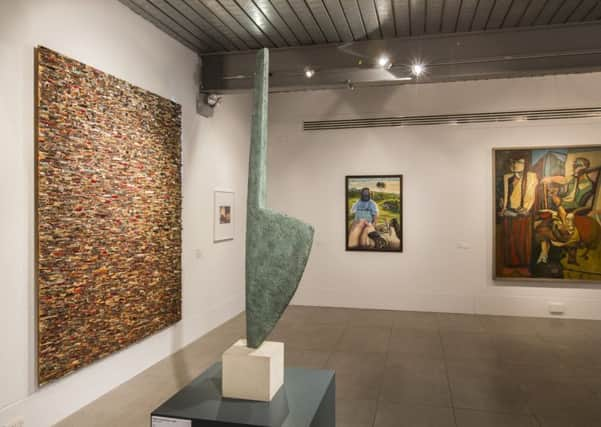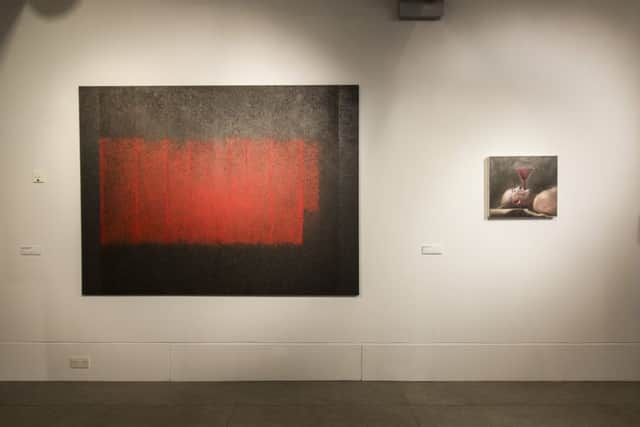Art review: The Scottish Endarkenment: Art and Unreason 1945 to the Present


The Scottish Endarkenment: Art and Unreason 1945 to the Present | Rating: **** | Dovecot Studios, Edinburgh
The Scottish Enlightenment is familiar enough, but now the organisers of an exhibition at Dovecot devoted to Scottish art since 1945 have come up with the contrasted idea of the Scottish Endarkenment. It is tongue in cheek perhaps, but the thesis is that in those years – especially more recently, to judge by the selection which is weighted towards the younger generation, – Scottish artists have shown a preoccupation with the darker side of life. “All these artists,” we are told, “in their inventive and distinctive ways have unflinchingly confronted and visually articulated deep doubt and fears which we all experience in a troubled and uncertain world.” It is not exactly the dark pole opposite of the 18th century’s pole of enlightenment then, more a rather gloomy tendency.
Advertisement
Hide AdAdvertisement
Hide AdThe beautiful display space at Dovecot is divided into two, matching the footprint of the swimming pools that they replace. In this show, the larger South Gallery is devoted to artists who share political, historical and social concerns, while in the smaller North Gallery they contemplate questions of the self and personal identity. Well, that’s the idea anyway, but there doesn’t seem to be any very clear distinction between the work in the two galleries.


With more than 30 artists overall, the older generation who came of age in the post-war years are represented by Ian Hamilton Finlay, Alan Davie, Robert Colquhoun, Eduardo Paolozzi, William Turnbull and Joan Eardley. Only one artist, William Johnstone, represented by a single piciture, is older than these six. Colquhoun’s magnificent Figures in a Farmyard, with a ferocious pig glaring at us past two figures with mask-like faces, is one work that really does catch the spirit of insecurity of the post-war years. Nearly contemporary, Davie’s Woman Bewitched by the Moon No 2, a writhing, visceral mass of paint, is also very powerful. Paolozzi’s bronze figure, Black Devil, matches it in expressive power, but on a miniature scale. Pat Douthwaite was a slightly younger member of this post-war generation and her Dancing Nude, typical of her tense, neurotic work, catches the same mood. In contrast, Ian Hamilton Finlay’s Et in Arcadia Ego is dark enough in subject. It illustrates the theme of omnipresent death in Poussin’s painting of the same name, not with wondering shepherds, but with a tank lurking in the undergrowth; carved in stone, it is very cool in execution. William Turnbull’s two bronzes, Head and Blade Venus 2 are likewise cool, not dark. Indeed the latter has an airy lightness about it which doesn’t really match the show’s thesis at all. Nor really does Joan Eardley’s Children and Chalked Wall. It is a lovely picture and although her sitters are undoubtedly children of the deprived streets of Glasgow that doesn’t really seem to be her point. Rather the children and the graffiti behind them illustrate the vitality that can flourish even in deprived circumstances, not the deprivation itself.
John Bellany and Steven Campbell were two artists whose work certainly did explore the darker side of life, but they are both represented by works that are relatively light in spirit and in tone. Bellany’s Ettrick Shepherd is a simple enough painting of a shepherd and his sheep. It is only when you identify its subject with James Hogg, the Ettrick Shepherd and author of one of the great “dark” books of the early 19th century, indeed of the actual Enlightenment, the Private Memoirs and Confessions of a Justified Sinner, that the picture illustrates the chosen topic. Lys Hansen’s Grip, a fierce painting of a huge face and fingers twisted into each other, is described as “the central panel from the Divided Self trilogy.” If so, this would also link it to James Hogg. Steven Campbell was capable of matching and indeed surpassing such ferocity. He was also no stranger to the divided self idea, but his large watercolour, Untitled (Psycho Rug naked girl black dahlia etc.) is a quiet and fairly slight picture. It really only makes an impact when you know how the artist liked to use rugs as a metaphor for the darkness hidden “under the carpet” in an apparently tranquil bourgeois world. Douglas Gordon’s Monster, two pictures of a face, one normal, the other wrapped in Sellotape to make a monster, also seems to illustrate the divided self idea and so perhaps suggests the thinking from which this show started.
Ken Currie has also painted some fierce and dark pictures. Red Funnel that represents him here shows the head and shoulders of a naked man on his back with a blood coloured funnel in his mouth. It suggests some horrific medical procedure or worse. As always with Currie, it is beautifully painted, too, but it is also enigmatic. So too is Ken Dingwall’s big and impressive painting Between Dark and Dark. It is richly textured with contiguous bands of red scumbled over a dense surface of black. It certainly has the right title for the show, but its execution is notably restrained and whatever darkness may have inspired it, nothing is revealed. It too remains enigmatic. Alison Watt’s Black Star, a particularly beautiful example of her fold paintings, also seems to qualify for inclusion more for its title than anything that it represents. Joyce Cairns’s Shoes from Madjanek, a large painting of a tragic heap of the shoes of Holocaust victims, does illustrate a wider and deeper modern darkness. Kenny Hunter’s I Love Rapid Change, a plaster model of the cloud over Hiroshima, offers an eloquent counterpoint to her image, too. Here we are certainly in the territory of endarkenment, though it is by no means exclusively Scottish. In the same gallery, however, Jock McFadyen’s Calton Hill with a huge moon over the Edinburgh skyline, is simply a beautiful, romantic painting of the night. Katie Paterson takes a different, ultimately astronomical approach with four photographs of the darkness of outer space. Julie Roberts’s The Dead Artists, a sequence of deathbed pictures of artists, is plain gloomy, but I really cannot see the point at all of including Simon Starling’s essay in botanical relocation, Rescued Rhododendrons, in which he took some of the plants from Scotland back to their original landscape in Spain. If there was a point in this context, it might be that the wanton transplantation of species is a still-evolving disaster, but that doesn’t seem to the idea. Nor does Parallel Incremental Sophistication (Head Lung Dead) by Beagles and Ramsay really seem to me to be “a monument to Mammon made out of empty cardboard boxes.’”
Nevertheless, although this show is more an anthology than an essay on a closely argued theme, there is some very striking work. Matthew Inglis’s Success, for instance, a ladder studded with nails with a pair of feet the top and a pair of hands at the bottom, would be a remarkable piece in any context.
• Until 29 August